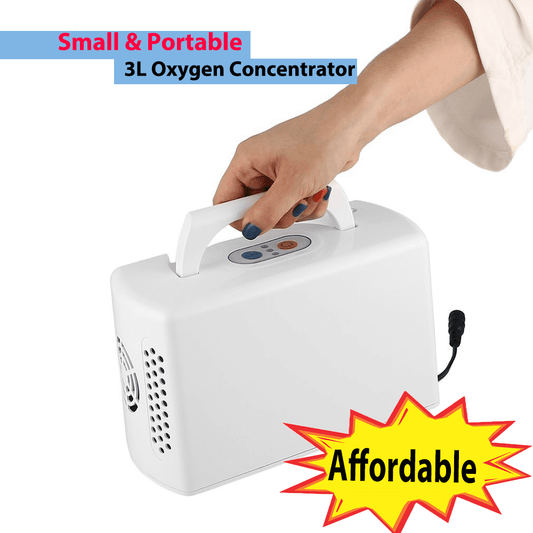What is oxygen therapy? When is oxygen therapy needed?
Oxygen Therapy (Oxygen Therapy): Treating a patient with a gas that has a higher oxygen concentration than air.
Hypoxemia: Refers to a decrease in arterial partial pressure of oxygen (PaO2) in the blood. Most scholars regard PaO2<60 mmHg and transcutaneous oxygen saturation (SpO2)<90% under standard atmospheric pressure as the standard of hypoxemia.
Hypoxia: Refers to the pathophysiological state in which oxygen supply is insufficient to meet oxygen demand. Oxygen therapy can improve hypoxia to some extent, but the degree to which oxygen therapy can improve hypoxia depends on the type of hypoxia. Hypoxia can be divided into 4 categories according to its causes: hypotonic hypoxia, blood hypoxia, circulatory hypoxia, and tissue hypoxia.
Oxygen therapy refers to the treatment of various types of hypoxia. In addition to eliminating the cause of hypoxia, oxygen therapy can be given. So when do you need oxygen therapy?
Basic principles of oxygen therapy
The main features of hypoxemia are decreased PaO2, decreased SaO2, and insufficient tissue oxygen supply. Alveolar partial pressure of oxygen (PAO2) is the result of a dynamic balance between alveolar oxygen delivery (DAO2) and alveolar oxygen uptake (O2EA). Oxygen therapy is to increase the concentration of inhaled oxygen (>20.9%), which can increase the alveolar oxygen partial pressure (PAO2) and increase the oxygen partial pressure gradient on both sides of the alveolar-capillary membrane, thereby promoting oxygen diffusion and improving arterial blood pressure. Oxygen partial pressure (PaO2) and blood oxygen saturation (SaO2).
When PaO2 exceeds 60mmHg and continues to rise, the increase of SaO2 and CaO2 is very limited and almost unchanged. If the oxygen dissociation curve does not shift left or right due to changes in pH or body temperature, when PaO2 is 60mmHg, SaO2 is about 92%. Under the oxygen dissociation curve without shift, when PaO2 exceeds 60mmHg and continues to increase, SaO2 can only increase from 92% to 100%. Therefore, the goal of all oxygen therapy is PaO2 up to PaO2 60mmHg, which is the basic principle of oxygen therapy.
In most clinical situations, for critically ill patients, although it is desirable to elevate PaO2 to a higher level (80-100 mmHg) in a short period of time, it is necessary to prevent the deterioration of gas exchange such as airway suction or change of position for emergency treatment. However, it is rarely necessary to raise PaO2 above 150mmHg.
Indications and main principles of oxygen therapy
- PaO2 standard for oxygen therapy: Generally speaking, PaO2<60mmHg is an indication for oxygen therapy.
- Type II respiratory failure (ventilation dysfunction): hypoxia with CO2 retention mainly due to decreased alveolar ventilation. The general principle of oxygen therapy is continuous low-flow (25% to 30% oxygen concentration) oxygen inhalation. According to whether there is an increase in alveolar gas-arterial oxygen partial pressure difference [P(Aa)O2], it can be divided into two types: ① P(Aa)O2 increases in severe COPD, chronic bronchitis, emphysema and other diseases. ② P (Aa) O2 is normal when the central nervous system or neuromuscular disease is present.
- Type I respiratory failure (ventilation dysfunction): Oxygen therapy has a better effect on patients with hypoxemia caused by ventilation/perfusion disorders and diffusion disorders, but is not effective on patients with hypoxemia caused by arteriovenous shunt. Often, high-concentration (>60% oxygen concentration) oxygen therapy on the basis of mechanical ventilation is required to correct hypoxemia. After the hypoxia is corrected, the oxygen concentration should be adjusted to an appropriate level to prevent oxygen poisoning.
- Recovery during or after surgery under anesthesia.
- In critical illness, including cardiopulmonary resuscitation, major trauma, shock, sepsis, acute myocardial infarction, acute or severe cardiac insufficiency, prolonged labor during delivery, acute severe allergic reaction, acute respiratory distress syndrome, etc., oxygen should be given in time treat.
(1) Cardiopulmonary resuscitation: During cardiopulmonary resuscitation, on the basis of keeping the airway open and artificial respiration in time, high-concentration oxygen is inhaled for a short time. If conditions permit, a balloon-mask can be used to breathe (if conditions permit, an oxygen storage bag can be connected to provide 100% oxygen), which is convenient for transfer to the hospital for treatment with a ventilator.
(2) High-flow oxygen inhalation therapy should be given to patients with severe trauma, shock, sepsis, acute myocardial infarction, acute or severe cardiac insufficiency, prolonged labor during childbirth, and acute anaphylactic shock. These patients started oxygen therapy with oxygen storage masks (15L/min), and it is advisable to adjust their oxygen concentration after waiting for their condition to improve.
(3) The oxygen therapy guideline for patients with acute respiratory distress syndrome is to correct their severe hypoxic state in a timely manner. Usually, continuous positive airway pressure (CPAP) is used to inhale oxygen, but most of them need to inhale oxygen through mechanical ventilation. Lung protection is recommended. Ventilation strategy [(low tidal volume ventilation, permissive hypercapnic ventilation, optimal positive end-expiratory pressure (PEEP)].
- Although some patients with COPD, pulmonary interstitial fibrosis and other diseases have been treated, in a resting state, when PaO2 continues to be <55mmHg or SaO2<85%, long-term home low concentration (nasal catheter 1-4L/min) is required. Oxygen therapy, the oxygen therapy time is not less than 19 hours a day, especially when sleeping at night.
Purpose of oxygen therapy
➤ Patients with hypoxic hypoxia
Raising PaO2 to just over 60mmHg (8.0kPa) can give the minimum oxygen concentration. After oxygen inhalation therapy in these patients, PaO2 rose to 50-60mmHg (6.67-8.66kPa), and SaO2 rose to over 85%. safe level. Attempts to further increase PaO2 will not result in a significant increase in blood oxygen levels, but there is a risk of oxygen toxicity.
➤ Patients with normal PaO2 hypoxia
Blood hypoxia, circulatory hypoxia and tissue hypoxia, usually PaO2 and SaO2 are basically normal, inhalation of high concentration oxygen or hyperbaric oxygen can improve the effect on tissue cells by increasing the amount of dissolved oxygen for hypoxic patients with normal PaO2 Oxygen supply, and reduce myocardial work caused by tissue hypoxia. In carbon monoxide poisoning, inhalation of higher concentration of oxygen therapy can accelerate the dissociation of HbCO, which has a certain therapeutic effect. Patients with severe CO poisoning can be treated with hyperbaric oxygen chamber. In various cyanide poisoning and other tissue toxic hypoxia, although the effect of oxygen absorption is not obvious, the oxygen partial pressure gradient between the blood and the tissue can be increased through oxygen therapy, and the diffusion of oxygen to the tissue cells can be increased, which can be cured to a certain extent. effect. Cyanide poisoning can also be treated with a hyperbaric oxygen chamber, where more inhaled high-pressure oxygen can force the poisonous gas in the blood out. This helps to quickly remove toxins from the blood and prevent brain disorders caused by toxicity.


DEDAKJ Oxygen Concentrator
Established in 1953, with ISO, CE, RoHS and PSE certifications, with medical oxygen concentrators and home oxygen breathing machines as the core, DEDAKJ is the top-rated oxygen concentrator supplier,offers the mini &small oxygen concentrator, household portable oxygen making machine, the medical grade 10 liter oxygen concentrator for hospital oxygen therapy &clinics oxigenoterapia. More The DEDAKJ Oxygen Concentrator store website offers the DEDAKJ original oxygen accessory oxygen parts & components. All DEDAKJ oxygen machine oxygen concentrators concentrador de oxigeno and original oxygen accessories parts can be bought here.
Buy online the best quality portable oxygen concentrator in DEDAKJ oxygen concentrator store.
Buy DEDAKJ Oxygen Concentrator: https://dedakjoxygenconcentrators.com/






















